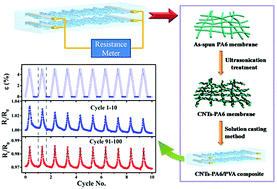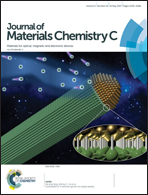A tunable strain sensor based on a carbon nanotubes/electrospun polyamide 6 conductive nanofibrous network embedded into poly(vinyl alcohol) with self-diagnosis capabilities†
Abstract
A new carbon nanotubes (CNTs)/polyamide 6 (PA6)/poly(vinyl alcohol) (PVA) conductive composite was prepared by embedding a CNT wrapped electrospun PA6 nanofibrous network into a PVA matrix. For this composite, CNTs were employed to pre-construct the conductive network by decorating the electrospun PA6 network. The effects of CNT content and the number of CNTs-PA6 layers on the tensile properties of the composite were investigated. The composite consisting of two layers of CNTs-PA6 conductive nanofibrous networks possessed a prominent integrated performance and was applied to evaluate its strain sensing capability. The resistance change of the composite under quasi-static tensile loading was classified into four stages, involving different damage modes. The performance of cyclic tensile tests revealed that the composite exhibited distinguishing strain sensing characteristics towards different deformation levels, which contributed to identifying the damage status of the composites containing conductive nanofibrous networks. A better repeatability has been achieved after several elongation/contraction cycles or pre-stretching treatment. This study opens up new opportunities to develop a nanofibrous network based tunable strain sensor with self-diagnosis capabilities for damage detection.

- This article is part of the themed collection: 2017 Journal of Materials Chemistry C HOT Papers


 Please wait while we load your content...
Please wait while we load your content...